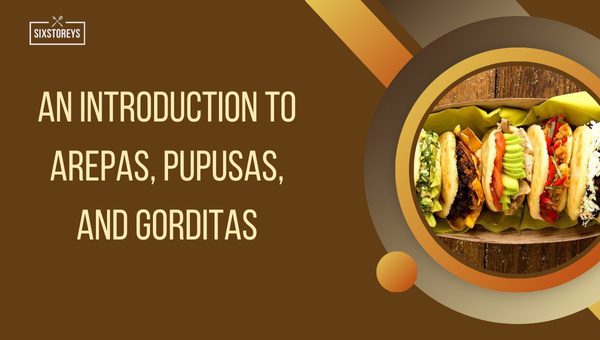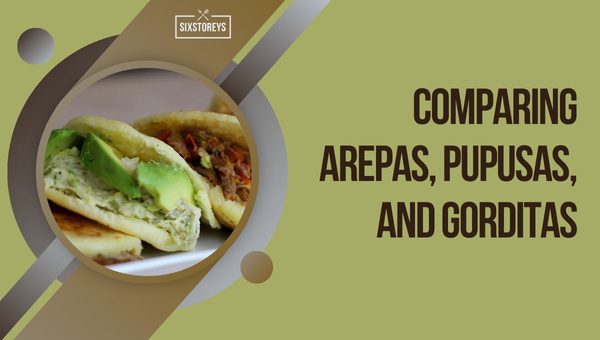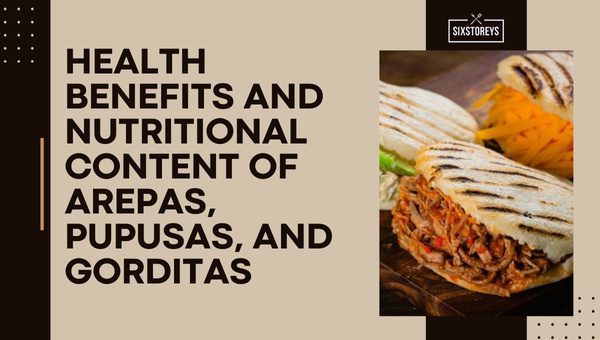Arepas Vs Pupusas Vs Gorditas: Cornmeal Clash of Titans
Culinary explorations can often lead us down delightful paths where we encounter diverse food cultures and taste the heart of different communities. Central and South American cuisine, in particular, offers a gastronomical journey filled with flavor, comfort, and tradition. Among the myriad of dishes that hail from this region, three stand out and often become the subject of rigorous debate: Arepas, Pupusas, and Gorditas. Each has its unique charm, taste, and texture, and picking a favorite can be as difficult as choosing a favorite song or movie. So, come join me as we embark on this delicious journey of understanding, comparing, and appreciating the diversity of these iconic Latin treats in our “Arepas vs Pupusas vs Gorditas” showdown.
Also Read: Gyoza vs. Dumplings
Article Includes
An Introduction to Arepas, Pupusas, and Gorditas

To fully appreciate the culinary brilliance of these three dishes, it's essential to understand their origin, how they're made, and what they symbolize in their respective cultures.
Arepas
Let's start with Arepas, a type of food made of ground maize dough, and prominent in the cuisine of Colombia and Venezuela. A staple dish for many families, Arepas are versatile and delicious, often served with a variety of fillings or used as a side to other dishes. The arepa is a simple, uncomplicated flatbread, but boy, is it power-packed with flavor! To an outsider, it may seem modest, but it speaks volumes about the rich culture from which it originates.
Pupusas
Next, we travel to El Salvador to meet their national treasure - the Pupusas. Handmade thick stuffed tortillas embodying a mix of flavors that are quite simply, inexplicably good. Be it stuffed with cheese, beans, or pork, a well-made pupusa is a package of pure joy. Pair it with a tangy side of curtido, and you're in food heaven! The art of making pupusas is beautiful to witness, almost as satisfying as eating them.
Gorditas
Finally, we arrive in Mexico, the land of spices and Gorditas. Translating to "little fat one," these are thick tortillas that puff up when cooked, creating a hollow center to pack in all those wonderful fillings. Gorditas are a celebration of flavors and cultures and are as much about the process of making them as they are about the enjoyment derived from eating them.
Comparing Arepas, Pupusas, and Gorditas

When appreciating dishes from different cultures, it's always enlightening to draw comparisons and understand the subtleties that set each one apart. So how do Arepas, Pupusas, and Gorditas hold up in direct comparison?
Arepas
Originating from Colombia and Venezuela, arepas are versatile dishes made of ground maize dough or cooked flour. They can be grilled, baked, fried, or even steamed. Arepas strike a balance between crisp and soft, and the best part is they are gluten-free. Typically, you can enjoy Arepas filled with meat, cheese, or even have it plain.
Pupusas
Pupusas from El Salvador are very similar to Arepas, but with distinct differences. Similar to Arepas, they are made with corn flour, but instead of being filled after being cooked, the fillings (which commonly include cheeses, squash, or refried beans) are added before they are cooked. This results in the flavors merging together beautifully, creating a savoury treat that's tougher to resist.
Gorditas
Gorditas, native to Mexico, might remind you at first glance of a thick tortilla. 'Gordita' translates to 'little fat one', which is an endearing reference to its puffy appearance. In contrast to Arepas and Pupusas, Gorditas are made from masa (a dough from ground nixtamalized corn) and are usually filled post cooking with delectable fillings like meat, cheese, or salsa.
Here's a comparison table highlighting the key points:
| Arepas | Pupusas | Gorditas | |
|---|---|---|---|
| Origin | Colombia/Venezuela | El Salvador | Mexico |
| Main Ingredient | Maize Dough/Cooked Flour | Corn Flour | Masa |
| Cooking Methods | Grilled, Baked, Fried, Steamed | Cooked with Fillings | Usually Fried |
| Fillings | Meat, Cheese, or Plain | Cheeses, Squash, Refried Beans | Meat, Cheese, Salsa |
| Gluten | Gluten-Free | Depends on Corn Flour used | Depends on type of Masa used |
Although Arepas, Pupusas, and Gorditas may seem similar at first glance, their unique features make them distinct culinary experiences, offering a taste of the rich cultural heritage they come from.
In the grand debate of Arepas vs. Pupusas vs. Gorditas, it's not about finding the best, but celebrating the taste, preparation, and cultural significance of each of these delightful treats.
Pairings and Servings: What Goes Well With Arepas, Pupusas, and Gorditas
Food, like any art form, is never enjoyed in isolation. The right complementary elements not only enhance its taste but create an offering that transcends the sum of its realities. Let's delve into the perfect pairings and servings that bring out the best in Arepas, Pupusas, and Gorditas.
Arepas
Arepas, a staple in Venezuelan and Colombian cuisines, often serve as a meal on their own due to their rich stuffing. However, they're usually also accompanied by:
- Hot Sauce: A good tangy hot sauce adds a bit of zest and spiciness to the inherent mild flavors.
- Guasacaca Sauce: Venezuela's avocado-based green delight, it adds a smooth and savory complement.
Pupusas
Pupusas, El Salvador's pride, tend to come with a crunch that beautifully contrasts with their soft, doughy insides. Here are a few popular pairings:
- Curtido: A fermented cabbage slaw, it provides a tangy crunch with a hint of heat.
- Salsa Roja: This delectable red sauce pairs brilliantly with the savory pupusas, enhancing their taste palate.
Gorditas
Follow the Mexican tradition of smothering your Gorditas with some standard accompaniments:
- Salsa: A delicious condiment, be it salsa verde (green) or salsa roja (red), is usually a staple.
- Crema: A Mexican sour cream, amping up the richness of your Gorditas.
- Queso Fresco: Sprinkle some fresh cheese for a dash of creaminess.
Each of these dishes has its own myriad of pairings which lend a whole new layer of flavor, taste, and enjoyment. To experience them fully, the best way is to try these combinations yourself and discover the ones that titillate your taste buds the most.
Health Benefits and Nutritional Content of Arepas, Pupusas, and Gorditas

When it comes to nutrition, these three staples from Latin America have their unique benefits. This, of course, can vary based on the specifics of the ingredients used and the preparation method.
- Arepas: These are primarily made from cornmeal, which is naturally gluten-free, making Arepas a safe choice for those with gluten intolerances. A basic arepa provides an excellent source of complex carbohydrates. When stuffed with healthy fillings like beans, grilled vegetables, or lean meats, they transform into a whole meal with balanced nutrients.
- Pupusas: Essentially, these are maize tortillas filled with a variety of ingredients. Like Arepas, they are gluten-free. The nutritional value highly depends on the fillings. Generally, they are rich in carbohydrates, and when filled with beans and cheese, protein as well.
- Gorditas: Translating to 'little fat ones', Gorditas are made from masa, or cornmeal dough. They are often stuffed with cheese, meat, and other fillings. The cornmeal provides a good helping of fiber, and when combined with protein-rich fillings, they offer a balanced array of essential nutrients.
Remember, while these treats provide beneficial nutrients, they should be eaten in moderation as part of a balanced diet due to their usually high carbohydrate content.
Where Can You Find Authentic Arepas, Pupusas, and Gorditas?
The taste of a food item is crucially tied to its place of origin. The authentic versions of Arepas, Pupusas, and Gorditas are best enjoyed in their native countries of Venezuela, El Salvador, and Mexico, respectively. However, with the growing popularity of Latin American cuisine, you're likely to find them in Latin restaurants around the world.
If you're in New York City, Caracas Arepa Bar is well-known for its authentic Venezuelan Arepas.
In Los Angeles, Atol de Elote serves Salvadoran pupusas that stay faithful to the classic recipe.
For Gorditas in Chicago, Gorditas Loli's is an established favorite among locals.
But the best part? These warm, comforting dishes can be made right in your own kitchen, with recipes easily available online.
Also Read: Udon vs Soba Noodles
Frequently Asked Questions
Which is healthier: Arepas, Pupusas, or Gorditas?
It's not easy to categorically state which is healthier as it depends on the ingredients used within each. Generally, all three are made from cornmeal, which is gluten-free and a good source of fiber. The fillings can vary greatly, so consider that when making a health-conscious choice.
Can I make Arepas, Pupusas, or Gorditas at home?
Absolutely! There are numerous recipes available online to guide you through the process. All three require some practice to perfect, especially when it comes to shaping and stuffing, but they are certainly achievable home-cooked meals.
What are the common fillings for these dishes?
Arepas and Gorditas are often filled with a variety of meats, cheese, and beans. Pupusas, while also filled with cheese and meats, typically include a mix called 'Curtido' - a lightly fermented cabbage slaw.
I am a vegetarian. Can I still enjoy Arepas, Pupusas, and Gorditas?
Absolutely. While they are often stuffed with meat, there are plenty of vegetarian options available. You can stuff them with beans, cheese, veggies, or even tofu.
Can I find Arepas, Pupusas, and Gorditas outside of their original countries?
Of course. The popularity of these foods has spread globally, and you can find them in Latin American restaurants around the world. Some cities also host food trucks that specialize in these delicious treats.
What's the best way to eat Arepas, Pupusas, and Gorditas?
There's no right or wrong way, it's largely based on personal preference. Some people enjoy them plain, others favor them with hot sauce or salsa. Pupusas are traditionally served with a side of 'Curtido' and tomato salsa.
Can I freeze and reheat Arepas, Pupusas, or Gorditas?
Yes, you can. It's best to freeze them separately on a baking sheet first and then transfer them to a freezer bag. To reheat, you can bake them in the oven or heat them in a skillet until they are warm. However, they taste best when freshly made.
Conclusion
After this delightful culinary exploration, it's clear that Arepas, Pupusas, and Gorditas each bring a unique flavor profile and sensory experience to the table. Whether it's the tender and crisp Arepas from Venezuela and Colombia, the mouthwatering stuffed delights of Pupusas from El Salvador, or the hearty and diverse Gorditas of Mexico, there is no contest when it comes to the charm of Latin American cuisine.
The real victory lies in enjoying these dishes in their most authentic form, savoring each bite, and appreciating the rich cultural heritage they carry. Remember, the best food is the one that not only feeds our stomach but our soul. And Arepas, Pupusas, and Gorditas do just that—each in their distinct, memorable way.

